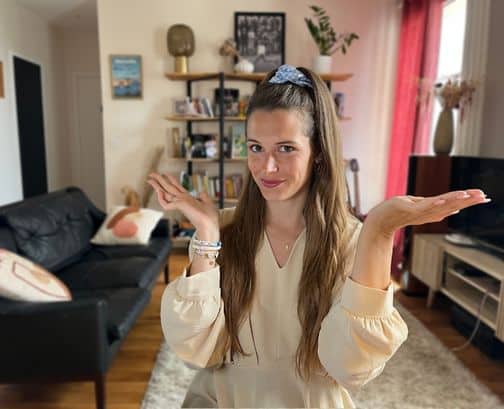Text of the video on learning French pronouns
Have you talked to your brother?
Yes.
Did you invite him to dinner on Sunday?
Yes, I invited him to dinner.
I invited him, you mean.
Hmm.
Lui, leur, le, la, les, l'. Are these little words really making life difficult for you, a French learner?
They're pronoun complements. A pronoun is a small word that replaces another word or group of words.
We use a pronoun to avoid repetition. But which complement pronoun to choose and how to choose it?
Some of these pronouns are designed to replace the masculine singular, others the masculine plural, others the feminine singular, and so on.
Welcome to this French video. I'm Elisabeth from the Hellofrench channel, where I post videos every week to help you improve your French.
In this video, I'll explain everything you need to know about pronouns that complete the direct object and pronouns that complete the indirect object.
Let's get down to brass tacks and start with C.O.D. direct object pronouns.
The direct object complement is the word or words that come directly after a verb in a sentence, attached to the verb.
🚀 Transform your understanding of French IN 15 MINUTES A DAY
60 dialogues to boost your understanding of French 🇫🇷
I invited my brother. My brother is a direct object. To find out if it's a direct object, you can ask the question "who?" for people and animals, and "what?" for objects.
Who did I invite? Mon frère to replace words or groups of words that make up a direct object complement.
You will use the following pronouns.
"The" to replace the masculine singular. "La" to replace the feminine singular and "les" to replace the masculine or feminine plural.
There's also the l', but we'll see that a little later in an example.
I baked a cake this morning, I'll eat it tonight. "The" comes here to replace a cake. A cake is a masculine singular. It is therefore replaced by the complement pronoun "the".
I eat a pizza, I share it with you. Pizza is feminine singular. We therefore replace it with the pronoun "la".
If the verb or auxiliary in the sentence begins with a vowel, then "le" or "la" changes to l'.
The vowel of the pronoun falls, you remove it.
Did you invite your brother? Yes, I did. Did you invite your sister? Yes, I did.
For the plural, you can replace the word group with the pronoun "les".
I like snails. I like them in sauce.
Let's move on to the pronoun you'll be using when you have an indirect object complement. An I.O.C.
Indirect object complements complete a verb, but they're not directly glued together. We're going to find the little word, the preposition "to" between the verb and the complement.
To find them in a sentence, you can ask the question "to whom?" after the verb when it refers to an animal or a human, and "to what?" when it refers to an object.
You can replace indirect object complements with the following two pronouns. The pronoun "him" will replace a masculine or feminine singular and the pronoun "their" will replace a feminine or masculine plural.
I phoned my mother. I phoned her. I lend my car to my sisters.
I lent it to them. That's it for today. Please let me know in the comments if you'd like to see more pronoun videos. I know these little words cause you a lot of trouble. If you liked the video, put a like and subscribe and activate the bell if you're not subscribed yet. See you soon!








